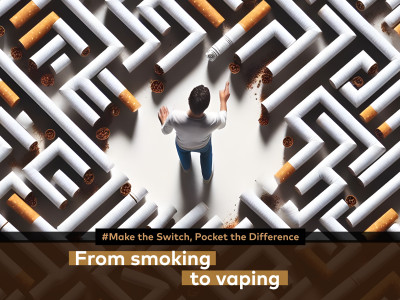‘Biomarkers of metal exposure in adolescent e cigarette users: correlations with vaping frequency and flavouring’ by Andrew Kochvar et al. has been published in the journal Tobacco Control. The media leapt on the findings to create shock tales about radioactive risk, but is it as bad as it seems? Research experts Professors Kevin McConway and Lion Shahab provide their opinions.
“Forget about collapsing lungs and heart failure,” sang the Metro, “vaping could be stunting the growth of teens’ brains due to toxic metals like lead and uranium.”
“Children as young as four have ended up in hospital with vape-related conditions like collapsed lungs as vaping fast becomes a ‘youth epidemic’,” the idiotic article continued.
The study’s authors wrote: “Youth vaping poses a significant public health concern as metals have been detected in e-cigarette aerosols and liquids. This study investigated factors associated with biomarkers of metal exposure.”
They concluded: “Vaping in early life could increase the risk of exposure to metals, potentially harming brain and organ development. Regulations on vaping should safeguard the youth population against addiction and exposure to metals.”
Professor Kevin McConway is an Emeritus Professor of Applied Statistics at the Open University. He commented: “There are so many sources of uncertainty about what’s going on here, and how the study’s findings can be interpreted, that I don’t think it can yet raise real health concerns. I’m certainly not saying that it’s a good thing for adolescents to vape – the risk of addiction to nicotine is a strong reason to discourage vaping in people who aren’t yet addicted. I certainly don’t want teenagers to vape. But it’s far too early to say that metals like lead or uranium coming from e-cigarettes are danger to the health of adolescent vapers.
“The research talks about young people, a group for whom any new health concern can be worrying to parents, health professionals, and others. It is about a habit, vaping in adolescents, which is generally frowned upon, though for reasons other than those raised in the new research findings. It mentions two substances (lead and uranium) that have genuinely scary connotations, but from different contexts than those investigated in the research. Simply putting those things together in one piece of research is likely to lead to concerns and anxieties that may well not be supported by the actual research findings.”
Professor McConway continued: “What the researchers found evidence of was an association, a correlation, between the self-reported frequency of vaping in a sample of 200 teenage (13-17) American users of nicotine-containing e-cigarettes and the levels of lead and uranium (but not cadmium) measured in their blood. The more frequently they said they vaped, the higher were their urine levels of lead and uranium. The pattern was statistically rather less clear for uranium than for lead, emerging only in a comparison between those who vaped frequently (20 or more days in a month) and those who vaped occasionally (1-5 days in a month).
“I’m no toxicologist so can’t comment on the risk to health of having lead or uranium in the body at the levels found in these adolescent vapers. It’s common knowledge that, at some levels, both lead and uranium are harmful to human health. But it’s interesting that the researchers point out generally that lead, uranium and their compounds are known to cause human health problems, without referring to the levels of lead and uranium actually found in the research participants. This research didn’t directly measure any health problems in the participants, only biomarker levels in their urine.
“More important, to me as a statistician at least, is that this research can’t establish that the higher levels of lead and uranium in the urine of participants who said they vaped more often were actually caused by their vaping. It’s possible that that was the cause, or at least part of it – but there are several alternative explanations, as I’ll describe.
“A basic issue is that this is an observational study – given what was being investigated, that’s the only practicable kind of study in humans, but it brings difficulties about cause and effect. The problem is that the participants with different frequencies of vaping also would have differed in many other ways. If some of those other differences – so-called potential confounders – are associated with different levels of the metals being investigated in people’s urine, then the association between vaping frequency and lead and uranium levels in urine could be caused by the other differences and not by vaping frequency at all.
“The researchers were, of course, aware of this issue and made some statistical adjustments to allow for some of the potential confounders – age, sex, a simple measure of race/ethnicity, whether or not they were exposed to second-hand tobacco smoke, and the type of vaping device they used. But these aren’t all the potential differences – the researchers would not have had data on everything relevant. Also in statistical terms they were probably limited in what they adjustments were possible by having only 200 participants, which is a pretty low number for a study like this.
“The researchers explicitly say, as a limitation of their study, that the sources and pathways of uranium exposure in their context ‘are not well understood’, and they say only that “uranium or its compounds could potentially be present in e-cigarette aerosols or e-liquids” (my emphasis). That is, they aren’t saying that they actually know that there is any uranium in the vapes at all. They point out that uranium in urine could come from other sources (natural deposits, industry, consumption in food or drink, for example) and the same is likely to apply to lead (and cadmium) too. Some of those other possible sources will vary according to where people live, which was not taken directly into account, though the researchers say that it should be considered in future research.
“So, we simply can’t conclude that different levels of lead or uranium in the urine are caused by differences in how often teenagers vape. That’s a possibility, but it’s far from the only one.
“There are other limitations too. One is that the study is cross-sectional – that is, the data come from one set of answers about vaping frequency and one set of urine measurements, made at roughly the same time, so there’s no way of knowing how metal levels in the urine might change over time as vaping levels change.
“There’s also the fact that the statistical analyses and results in this study were based only on a limited number of comparisons between participants in the survey from which the data came. The researchers excluded participants who were current users of other tobacco products, 203 people, which makes good sense because their urine lead and uranium levels could be affected by lead or uranium in the other tobacco products, such as cigarettes. But they also excluded over 1,000 survey respondents who did not use e-cigarettes at all. That’s a major reason why they ended up with only 200 participants in this research.
“In one way it does make good sense to omit all these non-vapers. People who have, for whatever reason, decided not to vape and not to use other tobacco products are likely to differ in many important ways from those who do vape, even if those included don’t vape often and don’t use tobacco otherwise. So leaving in the non-vapers would have made the issue of potential confounding even more serious than it already is. And it could be argued that any lead or uranium coming from vapes for someone included as an ‘occasional’ vaper, which means 1-5 occasions of vaping in a month, is not going to be much different from someone who says they vaped even less than that and was hence regarded as a non-vaper. But the fact that these non-vapers were omitted does draw attention again to the small number of participants, and so possibly to the difficulty of getting enough participants for the future research that the researchers recommend.”
Professor Lion Shahab is Co-Director of the UCL Tobacco and Alcohol Research Group. He joined Professor McConway in commenting about the study: “This study confirms previous work using the same dataset that e-cigarette users are exposed to some heavy metals, showing an increase in lead (though not cadmium) in the urine of US adolescents who exclusively used e-cigarettes intermittently (6 to 19 days in the last month) or frequently (20+ days) compared with those using e-cigarettes occasionally (1 to 5 days). The study also found an increase in the levels of uranium in occasional vs frequent users and in those using sweet compared with other flavours.
“This is a well-conducted study underscoring the need to carefully monitor exposure in e-cigarette users and highlights the fact that e-cigarettes are not risk free, and therefore should not be used by people who have never smoked, particularly adolescents. However, these findings also need to be seen in context.
- Uranium specifically has many different important sources of exposure (including food, water connected to geographic location), which were not controlled for in this analysis. Further, previous work has not found differences in uranium exposure between non-users and users of e-cigarettes nor detected uranium in e-cigarette aerosol, suggesting this finding may be explained by other factors.
- While lead has been found in e-cigarette aerosol (but again there are other important sources of exposure), the observed values reported here, even in frequent e-cigarette users (0.2 ng/mg creatinine), are below typical reference values from the general population and in line with previously reported data from the same study for adult non-users (around 0.35 ng/mg creatinine). Nonetheless, it is important to note that no level of lead exposure is safe.
- No control group (i.e., adolescents without any e-cigarette use) was included in the analysis.
“This study therefore cannot tell us anything about absolute increase in exposure to heavy metals from e-cigarette use in this population, only about relative exposure among less and more frequent e-cigarette users. Given that heavy metal exposure is mostly driven by the type of device used, future studies should investigate whether there are any meaningful differences between different e-cigarette types to inform regulators, e.g., to curtail use of devices that expose users to more heavy metals. The relatively small sample size in this study meant that this issue could not be investigated.
“Lastly, as is the case for most biomarker studies, it is difficult to translate these results into clinically meaningful effects. However, on the basis of such studies we know that e-cigarettes expose users to much lower levels of harmful substances than cigarettes but to higher levels than fresh air, so the best advice remains: if you smoke, vaping is much safer; if you don’t smoke, don’t vape.”
Photo Credit:
Photo by Yves Alarie on Unsplash
Dave Cross
Journalist at POTVDave is a freelance writer; with articles on music, motorbikes, football, pop-science, vaping and tobacco harm reduction in Sounds, Melody Maker, UBG, AWoL, Bike, When Saturday Comes, Vape News Magazine, and syndicated across the Johnston Press group. He was published in an anthology of “Greatest Football Writing”, but still believes this was a mistake. Dave contributes sketches to comedy shows and used to co-host a radio sketch show. He’s worked with numerous vape companies to develop content for their websites.








